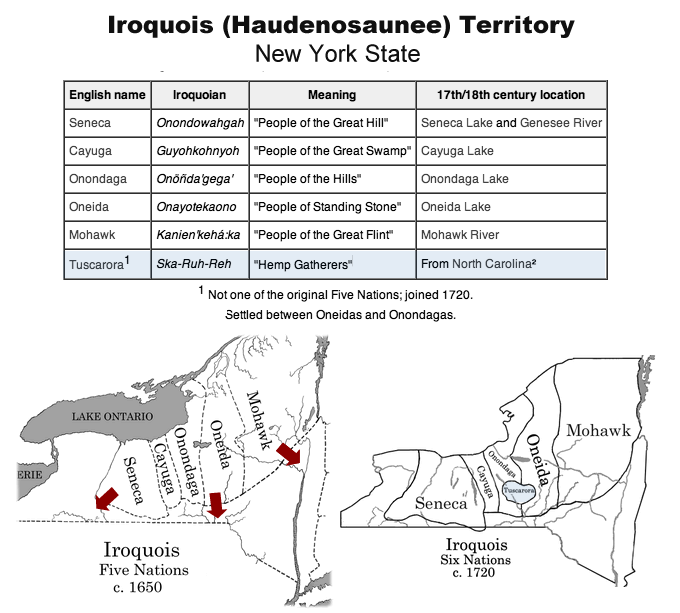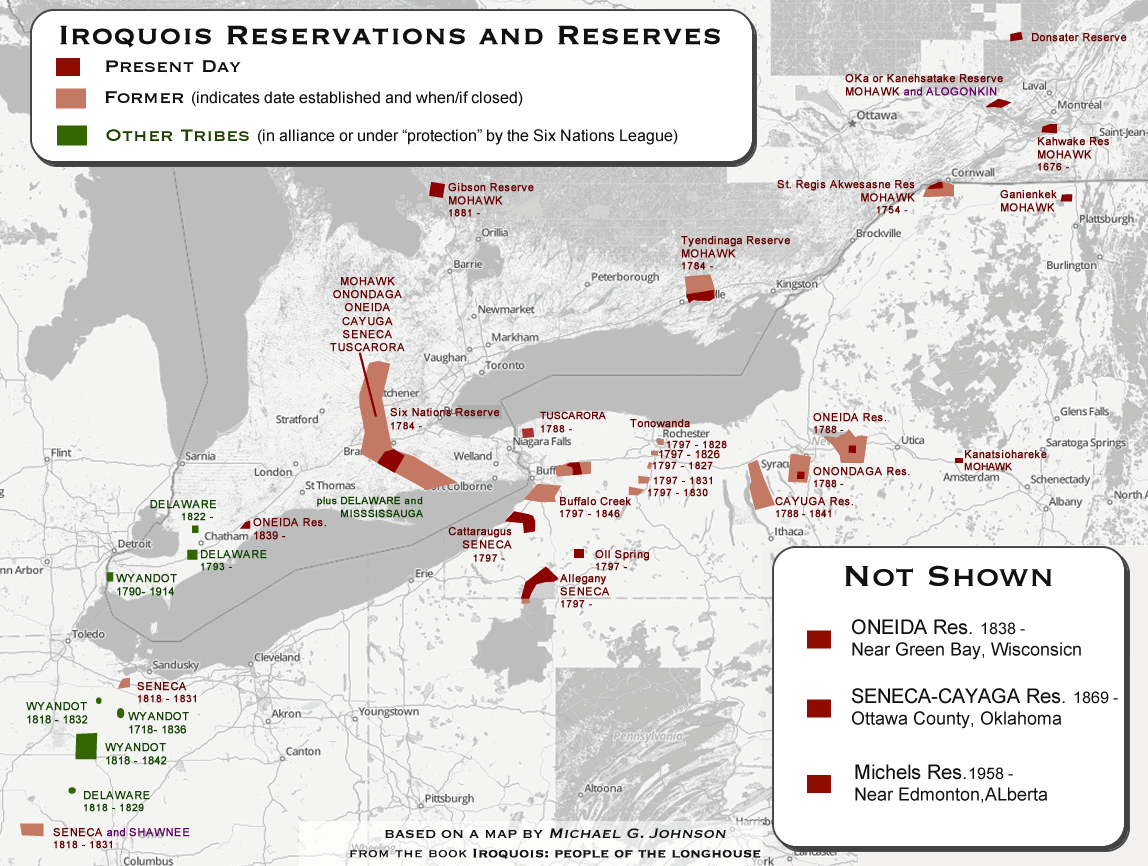This Land Was Theirs (Part Two)
Hudson and Mohawk Valleys - Native American History
Although the Iroquois are the Native American Group most associated with Upstate New York—the Mahicans, a rival Algonquian speaking tribe—also lived in the easternmost section.
Mohicans (Mahicans)
The Mohicans (Mahicans) were a confederacy of tribes originally living in what is now upstate New York, Connecticut, Massachusetts, and adjacent parts of Canada. Both the names Mahican and Mohican are correct are are used interchangeably, but NOT Mohegan,. The Mohegans are different tribe in eastern Connecticut who were related to the Pequot. In their own language, the Mahican referred to themselves collectively as the "Muhhekunneuw" "people of the great river" in reference to the mighty Hudson.
Mohican villages were fairly large. Usually consisting of 20 to 30 mid-sized longhouses, they were located on hills and heavily fortified. Large cornfields were located nearby. Agriculture provided most of their diet but was supplemented by game, fish, and wild foods. In the mid-1600s the Mohican became heavily involved in the Dutch fur trade.
It is difficult to estimate the Mohicans' population at the time of European contact. Scholarly estimates vary between 8,000 and 25,000 at the time of European contact. Regardless, by the early 1700s they would number only four or five hundred. Disease and alcoholism took its toll quickly among the Mohican population.
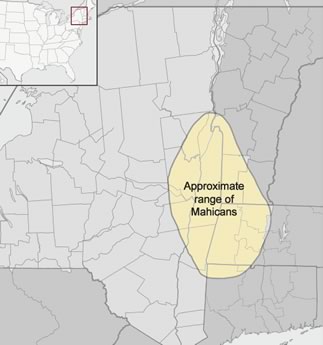
An area of historical and archaeological significance is the Schodack area that once consisted of three separate islands on the east side of the Hudson River below Albany. Schodack and Papscanee Islands were major Mohican village sites.
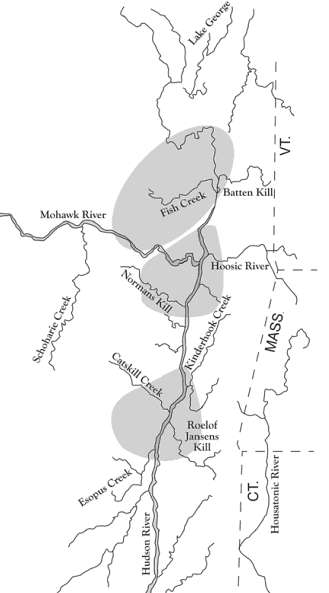
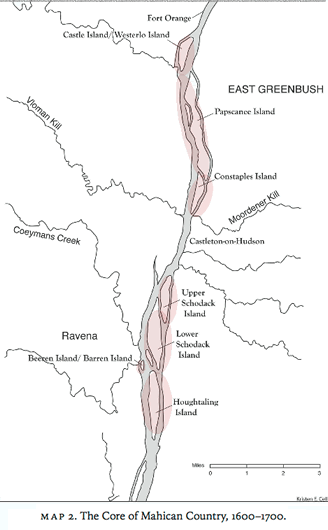
During the early to mid-eighteenth century there were a number of autonomous Mahican communities in and around the Hudson and upper Housatonic Valleys. They included Kaunaumeek, Freehold, Wechquadnach, Stockbridge, the mixed community at Shekomeko, a few others along the Hudson in Dutchess County, that at Westenhoek forming part of the Native population at Schaghticoke.
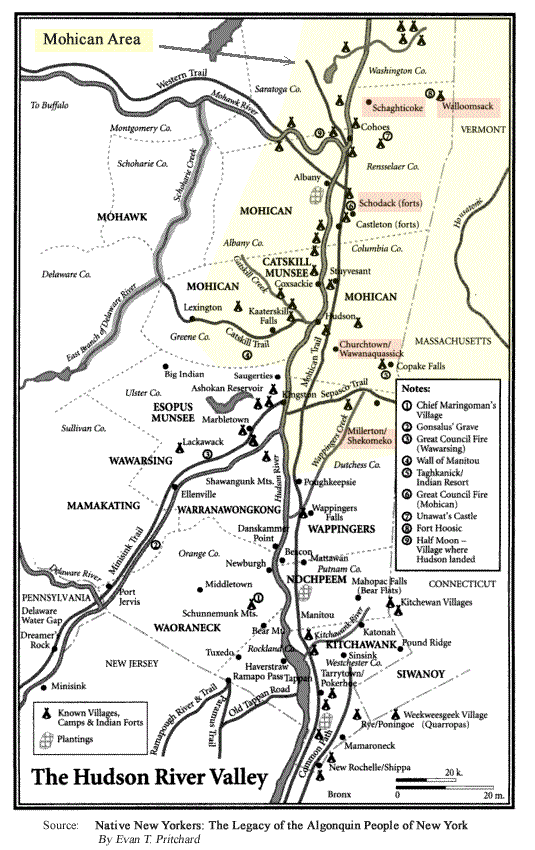
Migration
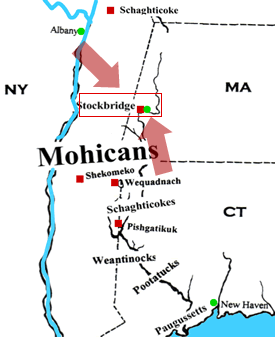 Their saga of survival took an interesting turn when after 1680—due to conflicts with the Mohawk—many moved to Stockbridge, Massachusetts where they gradually became known as the Stockbridge Indians. In the 18th century, many converted to Christianity, while keeping certain traditions of their own. In the eighteenth century, some of the Mahican developed strong ties with missionaries of the Moravian Church from Bethlehem, Pennsylvania, who founded a mission at their village of Shekomeko in Dutchess County, New York. Over time hostilities developed with white settlers and they were gradually cheated out of land.
Their saga of survival took an interesting turn when after 1680—due to conflicts with the Mohawk—many moved to Stockbridge, Massachusetts where they gradually became known as the Stockbridge Indians. In the 18th century, many converted to Christianity, while keeping certain traditions of their own. In the eighteenth century, some of the Mahican developed strong ties with missionaries of the Moravian Church from Bethlehem, Pennsylvania, who founded a mission at their village of Shekomeko in Dutchess County, New York. Over time hostilities developed with white settlers and they were gradually cheated out of land.
Following the disruption of the American Revolutionary War, a majority moved westward to New Stockbridge near Oneida Territory in central New York. The same pattern of land loss repeated itself. They left in the 1820s to join allies in Ohio, but there was no more land left. Eventually the Stockbridge-Munsee Band migrated to Wisconsin and established their present reservation in 1832. Fortunately the Mohican community stabilized there after the 1930s, and has experienced positive growth since then.
As mentioned in Part One, the area surrounding Schenectady and Saratoga was originally Mahican territory but they were permanently driven out by the fierce Mohawks.
Iroquois
The Iroquois called themselves the Haudenosaunee, which means "People of the Longhouse".The word “Iroquois” is not a Haudenosaunee word. It is derived from a French version of a Huron Indian name and was considered derogatory, meaning “Black Snakes.” Their original homeland was in upstate New York between the Adirondack Mountains and Niagara Falls. Through conquest and migration, they gained control of most of the northeastern United States and eastern Canada.
Prehistoric Iroquoian Occupations
The contour of the land, streams, lakes, lines of travel, and danger from enemies largely determined the early limitations of occupied territory. The primary centers of prehistoric Iroquoian occupations (recognized by archaeologists as Iroquoian), were:
- The St. Lawrence basin with Montreal as a center;
- The region between Georgian Bay and Ontario with Lake Simcoe as a center;
- The Niagara peninsula in Ontario following the Grand river;
- The Genesee River / Finger lake region;
- Chautauqua county, stretching across the Pennsylvania neck into Ohio;
- The highlands east of Lake Ontario in Jefferson county;
- Oneida, Madison, and Onondaga counties; and
- The Susquehanna River around Elmira.
Iroquoia
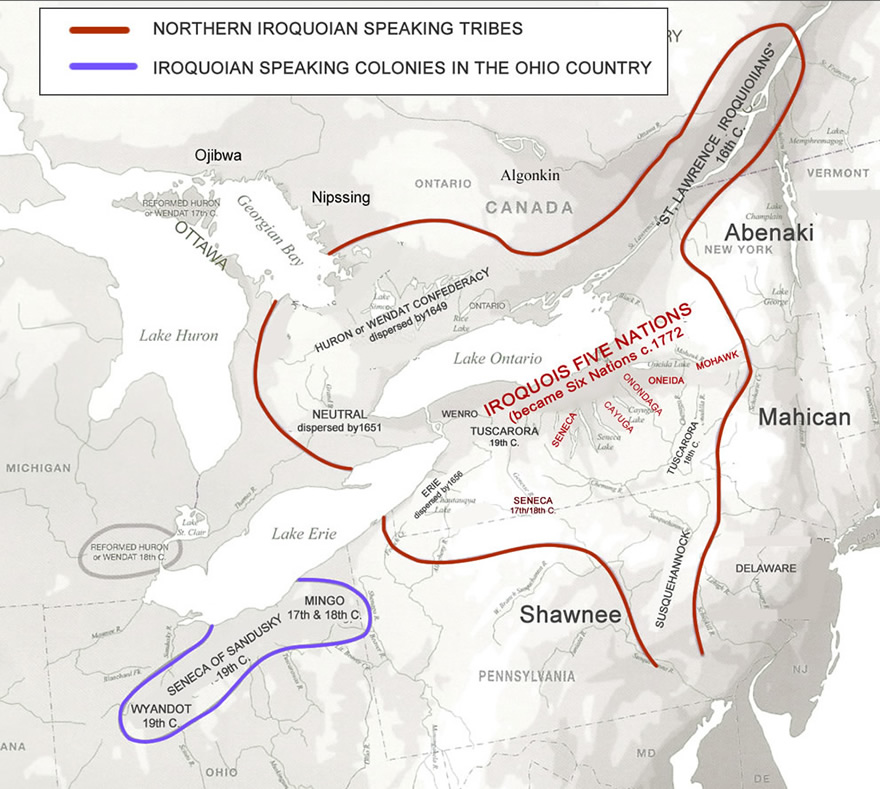
-16th Century Iroquois Sites in Upstate New York-
The Mohawk tribe occupied the area between the modern village of Little Falls and the city of Amsterdam. This tribal territory was approximately 40 miles wide from east to west and 20 miles wide from north to south.
Why Were These Sites Mapped Below Chosen By The Mohawk?
The Garoga, Klock, and Smith-Pagerie sites are all located in Ephratah Township, Fulton County, New York. They are situated on high, easily defended ridges in the drainage of Caroga Creek, a major tributary of the Mohawk River.The processes of erosion, and glacial infilling formed the ancient down-cutting streambed of Caroga Creek (similar to a number of other stream beds that dissect the valley). These drainage systems carried massive amounts of water down the valley floor. Over tens of thousands of years, these streams deeply incised the soft underlying sedimentary bedrock creating narrow and deep gorges or “hollows”
The highly developed series of meanders that characterized these tributaries created numerous isolated oxbows and ridges protected on three sides by stream-cut cliffs and embankments. Thousands of years after retreat of the Wisconsinan ice, which took place around 12,000 years ago, these elevated and isolated locations were sought after by the Mohawk Iroquois for the natural defenses they provided.
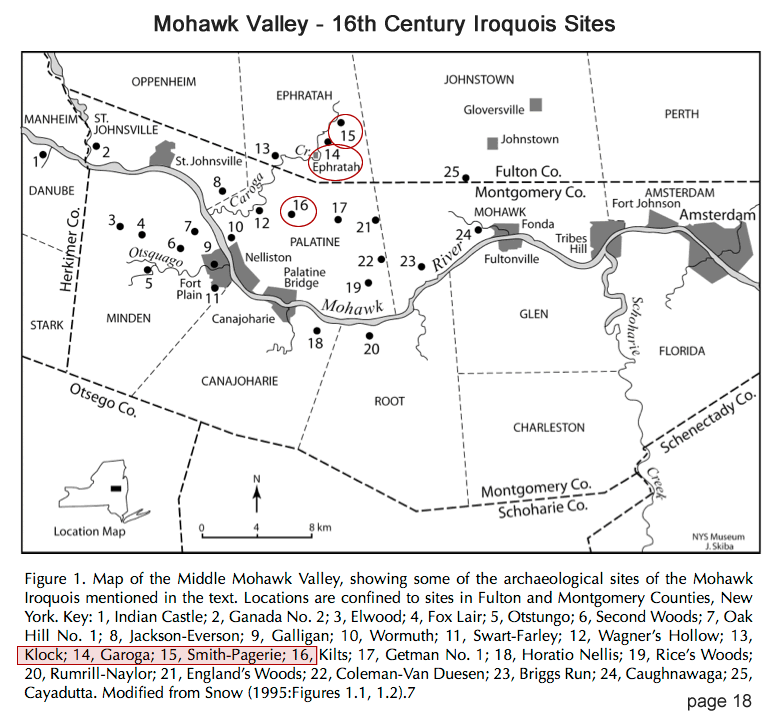


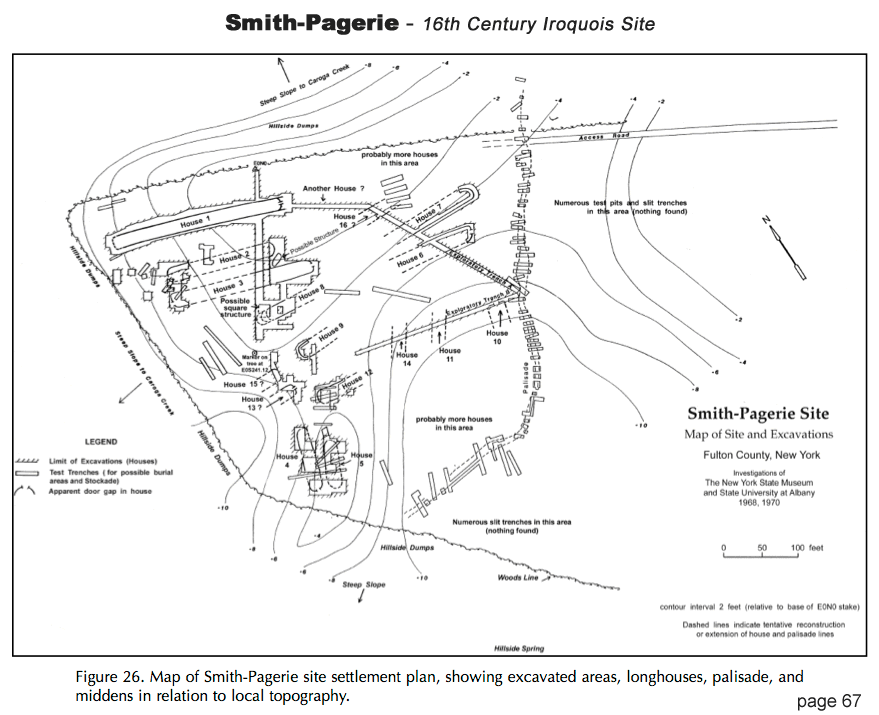
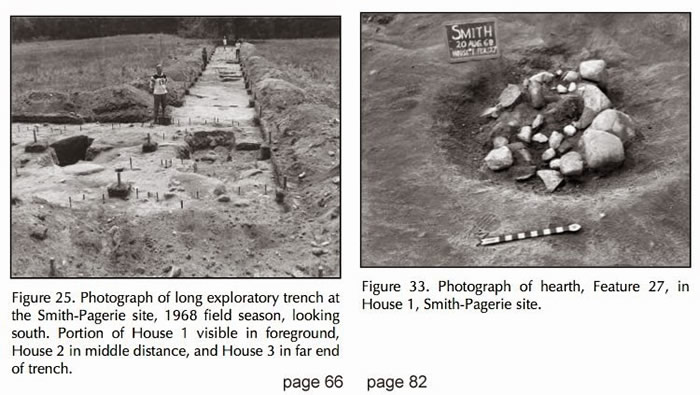
-Native American Trails-
Ballston Lake, NY has long been recognized as being on the trail leading from the Mohawk River at Rexford/Alplaus, north along the Alplaus Creek to the lake and thence north and northeast to Saratoga Lake and the Hudson Valley (see map below). Also, further travel east up the Hoosick Valley is known to have existed, which provided a means of entry into New England.
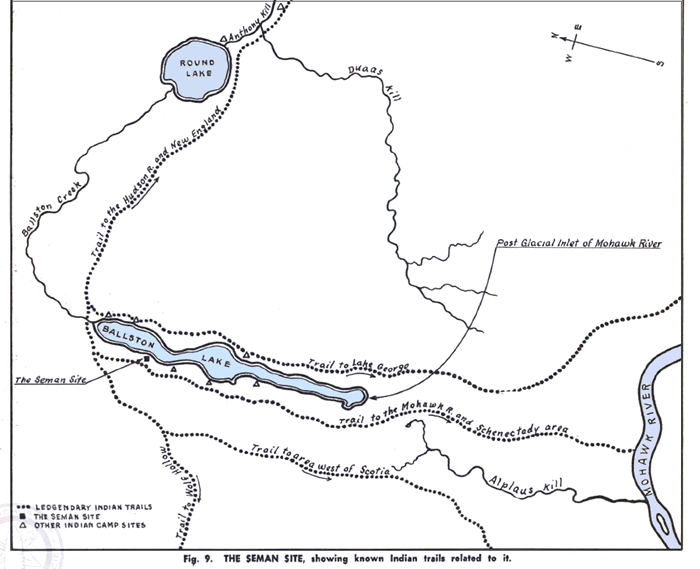
An old Indian trail once crossed the south end of the Lisha Kill, connecting the Normans Kill with a Mohawk village on Niska Isle in the Mohawk River, and used to access the nearby Helderberg Escarpment to quarry chert for stone tools.
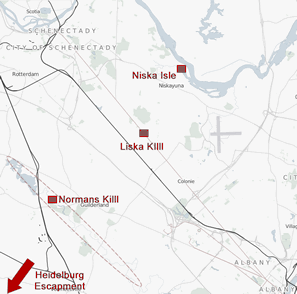
Artifacts
An interesting array of Irqouois artifacts have been recovered from various archaeological digs across New York.
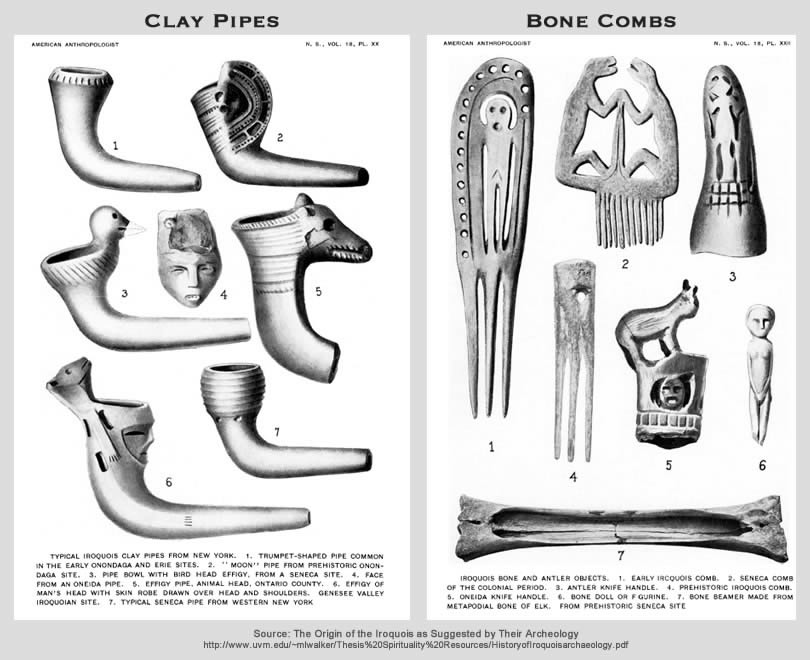
Where are the Iroquois Today?
Today Iroquois live scattered in a diaspora on the fringes of their original homeland as well as in two far flung communities on Oklahoma and Wisconsin. In 2010, more than 45,000 enrolled Six Nations people lived in Canada, and about 80,000 in the United States.
Further Info
Source credits and recommended reading (further study).
Mahicans
|
Iroquois |
|
 History Tidbits
History Tidbits